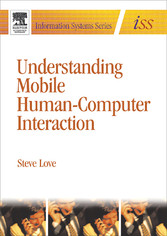Search and Find
Service
Cover
1
Contents
6
Acknowledgements
10
Glossary
12
1 Introduction to Mobile Human–Computer Interaction
14
BACKGROUND
14
INTRODUCTION
15
WHAT IS HUMAN–COMPUTER INTERACTION?
15
DISCIPLINES INVOLVED IN MOBILE HUMAN–COMPUTER INTERACTION
16
Psychology
17
Computer Science
17
Sociology
18
Design
18
Information systems
19
Know Thy User
19
MOBILE DEVICES
19
Mobile phones
20
Personal digital assistants
21
Laptops
22
Hybrid devices
22
Network accessibility
23
STRUCTURE OF THIS BOOK
24
REFERENCES
26
SUGGESTED FURTHER READING
26
2 User Characteristics
28
INTRODUCTION
28
SPATIAL ABILITY
28
PERSONALITY
30
MEMORY
33
VERBAL ABILITY
34
PREVIOUS EXPERIENCE
36
OLDER USERS
36
SUMMARY
41
REFERENCES
42
SUGGESTED FURTHER READING
44
3 Research Methods
46
INTRODUCTION
46
SETTINGS FOR YOUR STUDY
46
Laboratory settings
47
Field experiment
47
EXPERIMENTAL VARIABLES
48
EXPERIMENTAL DESIGNS
48
Repeated measures design
49
Independent samples design
49
Matched-pairs design
50
EXTERNAL AND INTERNAL VALIDITY
50
HYPOTHESES TESTING
51
SAMPLING TECHNIQUES
52
Biased sample
52
Random samples
52
Stratified sampling
53
Quota sampling
53
Cluster samples
53
Opportunity samples
54
SAMPLE SIZE
54
DATA COLLECTION METHODS
55
Questionnaire design
55
Scaler questionnaires
55
Semantic differential scale
58
Issues to be aware of in scaler questionnaire design
59
PERFORMANCE MEASURES
60
Task completion times
61
Errors
61
Interrupts
61
Silences
62
Retention
63
Observation
63
Audiotape recording
64
Videotape recording
64
Coding form
65
INTERVIEWS
67
Informal interviews
67
Semi-formal interview
68
Semi-structured interview
68
Structured interviews
69
Diary study
71
Triangulation
73
SUMMARY
73
REFERENCES
74
SUGGESTED FURTHER READING
75
4 HCI Research Methods
76
INTRODUCTION
76
VERBAL PROTOCOLS
76
Think aloud protocol
77
HEURISTICS
78
COGNITIVE WALKTHROUGH
81
SUMMARY
84
REFERENCES
86
FURTHER READING
86
5 Design Issues for Mobile Systems
88
INTRODUCTION
88
HUMAN-CENTRED DESIGN
88
Understand and specify the context of use
89
Specify user and organisational requirements
90
Produce design solutions
91
Evaluation
92
PRINCIPLES OF INTERFACE DESIGN FOR MOBILE SYSTEMS
93
Context of use
94
Consistency and learnability
94
Flexibility
95
System feedback and support
95
MOBILE INTERACTION STYLES
96
Text entry
96
Speech input
97
Speaker-dependent
97
Speaker-independent
97
Menu issues for automated mobile phone services
98
Conversational interfaces
99
Earcons
99
Metaphors
100
USER-CENTRED REQUIREMENT GATHERING TECHNIQUES
102
Card Sorting
102
Sketching
104
Brainstorming
104
PROTOTYPING TECHNIQUES
104
Paper and pencil prototyping
105
Emulators
105
Wizard of Oz prototyping
106
SUMMARY
108
REFERENCES
109
SUGGESTED FURTHER READING
111
6 Social Usability
112
INTRODUCTION
112
SOCIAL IMPACT OF MOBILE TECHNOLOGY
112
Public performance
113
Ethnography
114
Psychological perspective
115
Mobile workers
118
SUMMARY
120
REFERENCES
122
SUGGESTED FURTHER READING
124
7 Research Guidelines for Projects
126
INTRODUCTION
126
CHOOSING A TOPIC FOR STUDY
126
Literature search
127
Project description
129
Choosing appropriate methods for your study
129
Requirements gathering
129
Prototype design methods
132
Evaluation methods
132
Project plan
132
Project management
133
Problems with your project
134
Ethical HCI research
134
Analysis of data
137
Writing up your report
137
Tips on report writing
137
Title
137
Abstract
138
Introduction
138
Method
138
Participants
139
Materials
139
Procedure
140
Results
141
Discussion
142
Conclusions
143
Appendices
144
Reference list
144
OVERALL WRITING AND PRESENTATION STYLE
146
SUMMARY
146
REFERENCES
147
SUGGESTED FURTHER READING
148
8 Data Analysis
150
INTRODUCTION
150
WHY DO YOU NEED STATISTICS?
150
Describing data: numerically
151
Measures of central tendency
151
Describing data: tables and diagrams
155
Types of measurement
157
Numerical measurement
157
Category measurement
157
Parametric and non-parametric statistics
158
TESTING FOR DIFFERENCES
160
Related t-test
160
Unrelated t-test
162
Wilcoxon signed-ranks test
165
Mann-Whitney U-test
167
CORRELATIONS
170
Pearson’s Product–Moment Correlation
171
Spearman’s Rho
173
ANALYSING CATEGORICAL DATA
176
CHI-square test
176
Content analysis
179
SUMMARY
181
REFERENCES
183
SUGGESTED FURTHER READING
183
9 Conclusions
184
INTRODUCTION
184
3G TECHNOLOGY
184
Location-based services
186
Research methods
187
Education
188
Healthcare
190
Personalisation
190
SUMMARY
191
REFERENCES
192
SUGGESTED FURTHER READING
193
References
194
ADDITIONAL REFERENCES
200
Appendix A: Critical Value Tables
202
Appendix B: What Test shall I Use?
210
Appendix C: Useful HCI Resources
212
JOURNALS
213
Conference Proceedings
213
INTERNET
213
Index
214
A
214
B
214
C
214
D
214
E
214
H
214
I
215
K
215
L
215
M
215
N
215
O
215
P
215
Q
216
R
216
S
216
T
216
U
216
V
216
W
216
All prices incl. VAT











